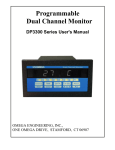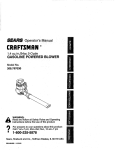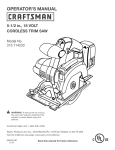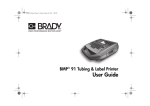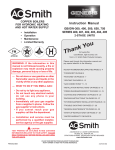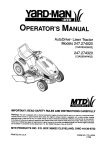Download White FR18CH Specifications
Transcript
SECTION 1 TROUBLESHOOTING STEERINGPROBLEMS PROBLEM Hard Steering REMEDY CAUSE Low Tire Pressure Check Pressure Chapter I1 Section 1 Lack of Lubricant Lubricate Chapter I1 Section 1 Bearings and/or Bushings worn Steering Disassembly and Inspection Chapter I1 Section 2 Tie Rods Bent Straighten o r Replace Chapter I1 Section 2 Steering Gear Broken Disassembly and Replacement Chapter I1 Section 2 MOWER PAN AND BLADEPROBLEMS PROBLEM CAUSE REMEDY Belt Off Pulleys Replace Chapter Section 3 I1 Belt Damaged Replace Chapter Section 3 I1 Blade Nut Loose Tighten Chapter 11 Section 1 Refer to Spec. Sheet -- Torque Blade Won't Disengage Blade Brake Not Working Check Blade Brake Tension Chapter I1 Section 3 Blade Leaves Swirl Marks in Lawn Pan Unlevel Correct Pan Level Chapter I1 Section 3 Blade Unlevel o r Bent Correct Pan Level Chapter I1 Section 3 Blade Won't Turn ONLY MODELS 9301,9302,9302E,9303E,9600,9601 MOWER .PAN AND BLADECont. PROBLEM Belt Comes Off (Rear) Belt Comes Off (Front) CAUSE REMEDY Belt Keeper Loose Tighten Chapter I1 Section 3 Broken Belt Replace Chapter I1 Section 3 *Top Idler Pulley Broken o r Bent Replace Chapter I1 Section 3 *Intermediate Shaft Loose Tighten Chapter I1 Section 3 Rear Idler Spring Broken Replace Chapter I1 Section 3 Rear Idler Arm Broken Replace Chapter I1 Section 3 Broken Belt Replace Chapter I1 Section 3 *Bottom Idler Pulley Broken o r Bent Replace Chapter 11 Section 3 *Intermediate Shaft Loose Tighten Chapter I1 Section 3 Idler Arm Broken o r Bent Replace Chapter I1 Section 3 Belt Pulley Bent o r Broken Replace Chapter I1 Section 3 *Diagram shown only. DRIVE PROBLEMS' I PROBLEM Mower Will Not Propel REMEDY CAUSE Improper drive adjustment Adjust Drive Disc Polished Score Chapter Drive Disc Broken Repair o r Replace, Chapter I1 Section 4 Chapter I1 Section 4 I1 Section 4 SERVICEBULLETINREFERENCES 11-18 REVISED 1977 MODELS 9301,9302,9302E,9303E,9600,9601ONLY DRIVEPROBLEMSCont. PROBLEM Mower Will Not Propel Cont. CAUSE REMEDY Rubber Drive Roller Worn o r Damaged Replace Chapter Section 4 Chain Loose Adjust Chain Broken Repair o r Replace, Chapter I1 Section 4 Transmission Rod(s) Bent Repair o r Replace, Chapter I1 Section 4 Differential Broken Repair o r Replace, Chapter I1 Section 4 Sprocket Worn o r Broken Replace Chapter Section 4 Will Not Drive In Check Reverse Booster Spring o r Disc. Compression Spring Chapter II Section 4 Reverse Clutch Pedal Must Be Pulled Back for More Drive I1 Chapter I1 Section 4 I1 Disc Compression Spring Adjust Chapter II Section 4 The following check list will assist in locating the problem source. FUEL PROBLEMS FUEL TROUBLE SHOOTING TROUBLES Engine will not start CAUSES REMEDIES a. Fuel tank empty a. Fill tank b. Water in fuel b. Drain fuel from tank and carburetor and replace with fresh fuel c. Old fuel in tank forms gum to plug up fuel line c. Empty out old fuel and clean out fuel line d. Shut-off valve closed d. Open valve MODELS 9301, 9302, 9302E, 9303E, '9600, 9601 ONLY FUEL PROBLEMS Cont. ~- Engine slows down and stops REMEDIES CAUSES TROUBLES a. Unplug hole a. Vent hole in fuel tank cap plugged i b. Clean out fuel line o r b. Fuel line or strainer clogged strainer c. Refill tank c. Fuel tank runs dry IGNITION PROBLEMS SPARK PLUG TROUBLE CHART PLUG CONDITION Black carbon o r sooty deposit CAUSES RECOMMENDATION a. Breaker points dirty or out of adjustment a. Clean and adjust gap b. Weak condenser b. Check and replace if weak I - c. Incorrect plug C. Install correct plug Pitted o r burned points, white, light tan or blistered deposits. Rapid wear of points a. Incorrect plug a. Install correct plug Cracked o r broken Plug a. Careless installation of Plug a. Replace plug Cracked or broken insulator on lower end of plug a. Center electrode strained when regapping Plug a. Replace plug Widening of gap a. Normal wear a. Clean and regap Disc MODELS 9301,9302,9302E,9303E,9600,9601 ONLY SPECIFICATIONS LUBRICATION SPECIFICATIONS Boy “A” Grease or Multiple Purpose, Automotive Grease Lawn-Boy“A” Grease or Multiple purpoSe,Automotive Grease “A” Grease or Multiple purpoSe, Automotive Grease #30 Weight Oil Grease For Front Axle& King Pin Spindle Front Wheel Bearings Differential Lawn-Boy Hexshaft Drive Roller BOLT AND N U T TORQUES Bolt King Pin to Tie Rod Nuts 135 inch pounds Steering Casting Bolts. 135 inch Steering Gear Set Screw 135 inch pounds Engine Mounting Bolts. 135 inch pounds Engine Pulley Drive Belt Pulley Nut. 250 Blade Nut600 DriveRoller Nuts Hexshaft Bearing Retainer Plate Screws Wheel Bearing Bolts 175 inch pounds Differential Bolts 135 inch Wheel NutsAdjustable pounds pounds pounds 250 inch 90 inch inch pounds inch pounds 90 inchpounds 35 inch pounds pounds ENGINE SPECIFICATIONS Idle r.p.m. Operating r.p.m. Oil Requirements Gas Tank Capacity Spark Plugs #‘s SERVICE BULLETIN REFERENCES 26” 30” 1,750 3,650 SAE10W/30 2 Qt. Champion CJ-8 o r Autolite A7N 1,750 3,650 SAE 10W/30 2 Qt. Champion CJ-8 o r Autolite A7N 11-21 REVISED 1977 ;9600, 9601 ONLY MODELS 9301,9302,9302E,9303E, TIRE SPECIFICATIONS 4.10/3.50~4 15-17 P.S.I. 480/400x8 22-25 P.S.I. Front Size. Pressure Rear Size Pressure 10x5/4.50-4 15-17 P.S.I. 16~5.50-8 22-25 P.S.I. BATTERY SPECIFICATIONS Approximately 2 quarts 24 3 amp Capacity Electrolyte Ampere Hour ChargingRate SERVICE BULLETIN REFERENCES REVISED 1977 MODELS 9301,9302,9302E,9303E,9600,9601 ONLY SECTION 2 HOW TO REPAIR AND REPLACE STEERING To insure trouble-free operation, use a grease gun and apply a good quality automotive chassis lubricant to the five zerk fittings. (Figure 2-1). Or Lawn-Boy “A” grease. A positive type steering system is employed. The steer- ing arm is keyed to the steering shaft and secured with a setscrew. The steering gear is linked to the left side spindle and kingpin arm. A tie rod connects the wheels. As you disassemble the front end, watch for bent or mis-shaped rods, dry bearings, bearings or bushings which are damaged, and shafts which are gouged or grooved. FIGURE 2-1 SERVICE BULLETIN REFERENCES 11-23 REVISED 1977 MODELS 9301,9302,9302E,9303E,i9600,9601 FIGURE 2-3 ONLY 04238 11-24 SERVICE BULLETIN REFERENCES REVISED 1977 MODELS 9301,9302,9302E,9303E,9600,9601 ONLY STEERINGDISASSEMBLY SPINDLE A N D / O R KING PIN REMOVAL Disconnect the spark plug lead. Remove thebattery,(electric start models only.) Stand mower on tilt (knurfing) bar. Remove front wheel. Remove tie rods from kingpin arm.Drive out roll pin. Remove spindlefromsteeringcasting. See Figures 2-3 and 2-4. NOTE FIGURE 2-4 RIGHT 94193 King pin a r m s a r e not identical (Figure 2-4). Care should betakento reinstall them properly. FRONT AXLE REMOVAL Disconnectthespark plug lead.Remove thebattery(electric start models only.) Stand moweron tilt (knurfing) bar. Remove spindle andking pin. (See spindleand/or king pin removal above.) Remove snap ring from pivot pin. Drive pivot pin from steering casting and axle. Remove axle. STEERING CASTING REMOVAL Disconnect spark pluglead.Remove battery,(electricstart models only.) Standmower on tilt (knurfing) bar. Remove front axle. Remove steering wheel and pedal support rod. Remove two bolts securing steering casting to main frame casting. Remove steering casting from main frame. IMPORTANT NOTE: Later model bushings contain two ridges which match the grooves in the frame castings. During reassembly the bushings MUST BE placed in the same position they were removed to prevent binding of the steering shaft. See Figures 2-5Aand 2-5B. Loosen the setscrew on the pitman arm. Using expansion pliers remove the retaining ring and remove pitman arm. CORRECT FIGURE 2-5A 04267 RIBS IN Disconnect spark pluglead.Remove battery, (electric start models only.) Stand mower on tilt (knurfing) bar. Remove steering casting. I INCORRECT 04268 STEERING CASTING DISASSEMBLY FIGURE 2-5B Remove all bolts holding castingtogether. Casting halves can then be separated (Figure 2-5). Pull steering shaft from casting. Note plastic bushings a r e ribbed for placement in casting--do not clean with solvent. The steering gear is held to the steering shaft with a retainer ring and a setscrew. n MODELS 9301,9302, 9302E, 9303E, 9600, 9601ONLY FIGURE 2-6 94173 \ STEERING WHEEL ALIGNMENT ! If steering wheel does not line up properly with frontwheels, it canbealigned as follows: 2. Loosen ,jam nut at ball joint socket 1. Remove nut securingballjoint pin arm. 3. Assemble ball jointto nut. to king and turn ball joint on o r off rod until steering wheel is aligned with front wheels. (Figure 2-6.j king pin a r m and MODELS 9301,9302,9302E,9303E,9600,9601 ONLY SECTION 3 ADJUSTMENTS POWERFORDRIVING To effect transmission of motivepower to the cuttingblade, two V-belts a r e used. The primary drive pulley which is located above the drive disc is keyed to the engine crankshaft. A short V-belt runsfromthis primary pulley totheupper pulleyon the intermediate spindle. A' longer V-beltconnectsthelower pulleyonthe intermediate spindle to thebladepulley on theblade shaft, driving the cutting blade. R ULLEY THE MOWERBLADE Two idler pulleys areusedintheblade drive system as illustrated below. A blade brake applied to the short belt (rear) stops the blade. The brake is applied by the control lever. As .the mower pan is disassembled, examine rods and suspensionassemblyfordamage or distortion, for bent o r misshapened rods, bearings or bushings which a r e damaged o r worn, drybearings, and shafts which a r e gouged o r ringed. PRIMARY BLADE DRIVE PULLEY INTERMEDIATE DRIVE PULLEY DISC PULLEY FIGURE 2-7 DUAL AND SPINDLE 94311 SERVICE BULLETIN REFERENCES 11-27 REVISED 1977 04242 SERVICE BULLETIN REFERENCES 11-28 REVISED 1977 MODELS 9301, 9302, 9302E,9303E.9600, 9601 ONLY MOWER PAN DISASSEMBLY PANREMOVAL Remove belt, and bell arm shoulder bolts. Remove front pan suspension bar shoulder bolts. Pan can now be removed frommower. FRONT BELT REMOVAL Disconnect spark plug lead. NOTE 1 I REAR BELT REMOVAL Use a rope as shown on Figure 2-10 when removing idler spring. Remove belt. Disconnect spark plug lead. Remove battery, (electric start models only). Remove rear cover. Remove belt keeper(Figure 2-11); tighten tilt (knurfing) b a r bolts. Stand mower on tilt (knurfing) bar. Reassemble in reverse order of disassembly. SAFETY WARNING SECURE TO WALL TO PREVENT THE MOWER FROM TIPPING OR FALLING. Rollbelt off the top intermediatepulley. Pull belt between drive disc and drive roller. Reassemble in reverse order of disassembly. FIGURE 2-11 IDLER A R M REMOVAL ~94181 Remove belt. Remove belt pulley. Remove andreplace idler arm. (See Figure 2-9.) SERVICE BULLETIN REFERENCES 11-29 REVISED 1977 MODELS 9301,9302,9302E,9303E,'9600,9601ONLY BLADE BRAKEADJUSTMENT When the blade control lever is placed in the “off” position, an adjustable leaf spring connected to the bell a r m and hub assembly is forced against the drive belt preventing the blade from rotating. SAFETY WARNING BLADE NUT MUSTBETIGHT BEFORE ADJUSTING BLADE BRAKE TENSION. SECURE MOWER TO PREVENT TIPPING OR FALLING. The blade brake leaf spring be adjustedto obtain blade stoppageinnot less than (4) four or more than (6) sixseconds with engine operating at 3600 RPM. 1. Use a right angle screwdriver to loosen the lock screw on the blade brake leaf spring. See Figure 2-12. To obtain proper bladebrake tension: 2. Move the spring in o r out until desired position,is obtained. Disconnect spark Plug lead- Remove battery, (electric start models only.) 3. Tighten lock Screw mower back on wheels. Stand mower on tilt (knurfing) bar. 4. Start engine,letting Lower it run about (2) two minutes'to warm up. 5. Place blade control lever in "off" position. Check bladestoppage by visually observingdrive pulley. DO NOT place FIGURE 2-12 94184 SERVICE BULLETIN REFERENCES 11-30 REVISED 1977 MODELS 9301,9302,9302E, 9303E, 9600,9601 ONLY PAN TILT ADJUSTMENT- 26” & 30’’ MODELS 1. Locate the mower on a flat level surface such as driveway, a sidewalk, garage floor, etc. 2. Place the height adjustment lever in the middle setting. 3. Rotatethebladeuntilthecuttingedge is facing the front of the mower and measure the distance from the ground to the tip of thecuttingedge of the blade. See Figure 2- 13. 180º and measure (from r e a r of pan) the distance’ from theground 4. Rotate the blade FIGURE 2-14 to the tip of the cutting edge of the blade. See Figure 2-13. 5. Themower pan tilt is Correct if the step 4 is 1/4 measurementobtainedin inchhigherthanthemeasurement obtained in step 3. 6. The pan tilt may be adjusted by removing the cotter pin on one end of the tilt adjust rod, loosen the jam nut on the clevis and turn the rod in o r out of the clevis until the required tilt is reached. Secure 2-14. clevis with jam nut. SeeFigure 7. See page 11-54 and check for bent blade. 94276 MODELS 9301,9302,9302E,9303E,9600,9601 ONLY SECTION 4 THEORY OF OPERATION INTRODUCTION The Lawn-Boy Riding Mower is powered by a verticalshaftfour-cyclegasolineengine mounted on the rear of the machine. The vertical crankshaft of the engine drives both the wheels and the cutting blade, with the speed of the forward motion determined by the Speed Selector Lever which provides three forward speeds, a reverse, and a neutral position. The speed of the cutting blade on the mower is determined by the revolutions per minute of the engine. The throttleallowsvaryingspeeds of theengine up to a maximum of 3600 rpm. Because of the selective controls of the Rider, it is possible to drive the machine without the cutting blade rotating, to drive the wheels slowly while the cutting blade and engine are at full 3600 rpm for maximum cutting in heavy growth, and to regulate from the driver's seat many combinations of speed and cutting heights. FIRST POSITION FIGURE 2-15 94316 POWERFOR DRIVING THEWHEELS The driving of the wheels is accomplished through the use of a large aluminum drive disc which is keyed to the vertical crankshaft of the engine. Because this disc always rotates at the speed of the engine, transfer of motive power at varying speeds is accomplished through the use of linkages, by bringing the rubber-tired drive roller into contact with the disc at three different positions from the center of the disc. The linear speed of any pointon a wheel is highest when the point is at the rim andslowest at the hub. The first position MODELS 9301,9302,9302E,9303E,9600,9601 ONLY shown, Figure 2-15, is nearest the center and is theslowestspeed, or First. Thesecond position shown, Figure 2-16, produces a higherspeed, o r Second, and the third position, Figure 2-17, near the rim of the disc produces the highest speed, or Third. In third position, the Rider will travel at approximately 6 mph. It is also characteristic of a rotating disc to transmit power in either direction, depending upon which side of the disc is brought into contact with the drive roller. The drive roller is shown, Figure 2-18, in contact with the disc on the opposite side of center. Note that the drive roller is quite close to the center for lowspeed,safe backing. In neutralposition,Figure 2-19, the' ,drive roller is not in contact with the drive disc. SECOND POSITION \ FIGURE 2-16 94317 The use of the large aluminum driving disc and the rubber-tired drive roller offer an advantage in that power can be transmitted to the wheel and speeds changed without the use of a clutch. The drive roller slides smoothly across the face of the turningdisc,making i t easy to start, change speeds, or go into reverse without clutching. The Rider does, however, provide a clutch to prevent engine choking out during sudden stops when it is not possible to shift the speed selector, and when parking the machine and shifting into gear when the engine is notrunning. Depressing the clutchlifts the driverollerfromcontact with the disc and prevents damage to the drive roller as it passes across the motionless driving disc. SERVICE BULLETIN REFERENCES 11-33 REVISED 1977 MODELS 9301,9302,9302E, 9303E,'9600, 9601 ONLY Inherent in the driving system of disc and drive roller making sudden contact is a tendency to lurch or buck when the machine is started from a dead stop. To make smoother starts possible, a series of sprockets and chains transmits the motive power from the drive roller to the wheels. In Figure 2-20 is shown the smooth transmission of power as the sprocket on the drive roller shaft turns a primary chain connected to the sprocket on the intermediate REVERSE POSITION FIGURE 2-18 11-34 SERVICEBULLETINREFERENCES REVISED 1977 MODELS 9301,9302,9302E,9303E,9600,9601ONLY driveshaft. The sprocket on that shaft, in turn drives an intermediate chain which drives a sprocket on the final drive spindle. The dual sprocket on the final drive spindle drives a final drive chain on the big sprocket mounted on the wheel axle to move the wheels. This combination of sprockets and chainsreducesstartingtorqueandabsorbstheshockand lurching of starting. 94311 SERVICE BULLETIN REFERENCES REVISED 1977 11-35 MODELS 9301,9302,9302E,9303E, '9600, 9601 ONLY To eliminatedriverollerslippage and to assure smooth starts, a system of two disc compression springs is employed. When the speed selector lever is placed in gear, the primarydisccompressionspringcreates initial drive roller pressure against the drive disc. Momentarily, the driveroller is allowed toslip,eliminating quick "jumpy" starts. The secondary disc compression spring thengoesintoeffectsupplying additional disc pressuretopropel the unit. (See Figure 2-21.) FIGURE 2-21 i - n NOTE 9301, 9302, 9302E 9600 have a single disc compression spring; 5 inch roller. Theory is the same. MODELS 9302,9302E,9303E,9600,9601ONLY NOTE 9303. 9303E, 9601 CHAIN TENSIONER SECONDARY COMPRESSION SERVICE BULLETIN REFERENCES 11-37 REVISED 1977 MODELS 9301,9302,9302E,9303E,9600,9601 ONLY PRIMARY DRIVE SERVICING DISC COMPRESSION SPRING REMOVAL _- Disconnect spark plug lead; remove battery, (electric start models only). Remove r e a r cover. Remove both disc compression springs. Models9301, 9302, 93023,and single disc compression spring. 9600 have The springsare not identical--tag a s outside. one as inside;theother Remove the springs with a rope. (See Figure 2-24.) RUBBER DRIVE ROLLER SERVICE Disconnect spark plug lead; remove battery, (electric start models only,) stand mower on tilt (knurfing) bar. Remove chaintensioner on primarydrive chain. (See Figure 2-22.) There will be enough slack to lift the chain off the hexshaft sprocket. Placespeedselectorinreverse. Remove fournutssecuringdriverollertoroller hub. Remove the two screws securing hexshaft bearing retainer plate and remove hexshaft and bearing. Beforereinstallingdriveroller, wash felt wick and apply a small amount of petroleum jellyto it (Figure 2-25.) Periodicinspection of the rubber roller and periodic lubrication of the felt oiler pad on the drive roller a r e the only regular maintenance operations on the drive roller. The rubber portion of the drive roller may crack, chip, or wear, but will be satisfactory as long as there are no large pieces broken out. After reassembly,adjust the driveroller. See Drive Roller Adjustment. FIGURE 2-25 11-38 SERVICE BULLETIN REFERENCES e . e. . .. .. .. a. s . REVISED 1977 MODELS 9301,9302,9302E,9303E,9600,9601 ONLY DRIVE ASSEMBLY ADJUSTMENTS DRIVE ROLLER TRAVEL HORIZONTAL Disconnect spark plug lead; remove battery, (electric start models only,) stand mower on tilt (knurfing) bar. The cast iron bearing carrier of the drive roller assembly must be in contact with the extended threaded ends of the screws holding the hex shaft bearing retainers to the drive bracket with theshiftlever placed in the fullreverseposition(Figure 2-26.) This will allowthe drive roller to move across the face of thedrive disc as the operator shifts through the three forward speeds or reverse. The driverollermust be readjusted whenever a new roller is installed. To obtain the correctadjustmentproceed as follows: 3. Turn ball jointonto the rod to lengthen travel--off rod to shorten travel (Figure 2-26.) Properadjustmentdoes not necessarily put thedriveroller on center line of drive disc when shift lever is in neutral. 4. When proper adjustment is made, attach ball joint to the bell arm assembly and tighten nut securely. Tighten jam against the ball socket. 5. This is necessary to retain correct rear speed. 1. Place speed selector lever in "reverse." Loosen jam nut on speedcontrol rod. (Figure 2-26.) 2. Remove nut securing ball joint stud to bell arm assembly. 681902 nut up FIGURE 2-26 SERVICE BULLETIN REFERENCES Inspect the drive disc closely. If the surface is polished the rubber drive roller will slip. Remove polish finish by rubbing in a circular pattern with sand paper or emery cloth. 94331 11-39 REVISED 1977 MODELS 9301,9302,9302E,9303E,9600,9601 ONLY FIGURE 2-27 94332 DRIVE ROLLER ADJUSTMENTVERTICAL ALIGNMENT When the speed selector lever is placed in neutral position, the drive roller disengages from the drive disc by use of various linkages. Proper clearance betweendrive disc anddriveroller is 1/16 inch with speed selector lever in neutral. See Figure 2-27. Thisassures the operator of a positive neutralposition and performs a secondary brakingaction by haltingthechain movement to the rear wheels. To obtaintheproper 1/16 inch clearance proceed as follows: 1. Placespeedselectorleverinneutral position. 2. Stand mower on knurfing bar to make adjustment. Seepage 11-41 for steps 3, 4, and 5 for models 9301, 9302, 9302E, 9600. See page 11-42 for steps 3, 4, and 5 for models 9303, 9303E, 9601. SERVICE BULLETIN REFERENCES 11-40 REVISED MODELS 9301,9302,9302E,9600 ONLY MODELS 9303,9303E, 9601, ONLY 3. Tighten upper reverseboosterspring nut until spring is compressed 1 1/2". See Figure 2-30. 4. Tighten orloosen uppernuton, speed controlclutchrodto obtain 1/16inch clearance between roller and disc. 5. Tighten remaining jam nuts. SERVICE BULLETIN REFERENCES 11-42 REVISED 1977 MODELS 9301,9302,9302E,9303E,9600,9601 ONLY DRIVE ROLLER ADJUSTMENT- SPRING TENSION A. Primary (inside) Disc Compression lbs., pressure andthe driveroller contact breaks disc.drive with the See Figure 2-31. Adjustment Spring 1. Place mower inhorizontalposition and remove rear cover. 5. Replacesecondarydisccompression spring. 2. Place speed selector lever in second gear. Do not depress clutchpedal. B. Secondary(Outside) DiscCompression Spring Adjustment (Figure 2-32). 3. Remove secondary(outside)spring. 4. Attach springscaleto hex shaft. While pulling downward on scale, rotate primary (inside) adjustable eccen4 to 5 tric untilspringscalereads 1. Attach springscaleto hex shaft. While pulling downward on scale rotate secondary (outside) adjustable eccentricuntilthespringscalereads FIGURE 2-31 24300 SERVICE BULLETIN REFERENCES 11-43 REVISED 1977 MODELS 9301,9302,9302E,9303E,i9600,9601 ONLY 15 to 17 lbs., pressure and the drive rollerbreakscontact with thedrive disc. in neutral position and re-checkthe 1/16 inch clearance between drive disc and, drive roller. 2. Place speed selector lever NOTE If drive roller slippage is observed, slightlyincreasethespringtension on thesecondary(outside)spring. If quick "jumpy" starts are observed, decrease spring tension on the primary (inside) spring. FIGURE 2-32 04299 MODELS 9301,9302,9302E,9303E,9600,9601 ONLY BRAKE ROD\ BRAKE BAND. 14076 BRAKE'DRUM INTERMEDIATE SHAFT' FIGURE 2-33 ROLL PINS PRIMARY CHAIN SECONDARYCHAIN SPROCKET ASSY MODELS INTERMEDIATE SHAFT FIGURE 2-34 0425 SERVICE BULLETIN REFERENCES 11-45 REVISED 1977 MODELS 9301,9302,9302E,9303E, '9600, 9601ONLY SECONDARY .DRIVE SERVICING Remove brake band from chasis. Remove secondary chain (Figure 2-35.) Remove bearing retainer plates fromchasis. Remove bearings and driveshaft. Replaceintermediatedriveshaftand reassembleinreverseorder of disassembly. Loosen nylon chain guide eccentric nut slightly and rotate into or away from chain to attain proper chain tension. Correct chaintension is 1/4 inchdeflection with light thumb pressure. WHEEL BRAKE ADJUSTMENT The friction type brake system consists of a foot pedal, brake rod, brakeand drum assembly. A s footbrake is depressed, a reinforced band on brake assembly is forced against the drum.Thisactionbrakesthe intermediate drive, thus stopping wheel rotation. To prevent damage to the drive roller, the clutch and brake must be applied simultaneously when making a stop. To adjust brake proceed a s follows: 1. Remove' cotter pin and washers from the brakerod at foot pedal. (Figure 2-36) and remove rod. 2. Loosen jam nuts at turnbuckle. See (Figo r out of ure 2-37). Screw brake rod in turnbuckle forproperadjustment which is obtained when slight pressure on the pedal encounters resistance after 1/2 inch pedal travel. 3. Tighten, jam nuts at turnbuckle and reassemble brake rod the to foot pedal. MODELS 9301,9302,9302E,9303E,9600,9601 FIGURE 2-38 FIGURE 2-39 ONLY 1A 0 7 9 04247 MODELS FINALDRIVE REMOVAL ‘9600, 9601 ONLY 9301,9302,9302E,9303E, DISASSEMBLY DIFFERENTIAL Disconnect spark plug lead; remove battery (electric start models only). SAFETY WARNING WHEN STANDINGMOWER ON END, ALWAYSANCHOR IT TO PREVENT FROM TIPPING ORFALLING.ALSO PLACE THROTTLE IN “STOP” POSITION AND DISCONNECT SPARK PLUG LEAD. Stand moweron tilt (knurfing) bar. Remove r e a r belt. ! Remove rods from carrier bracket and disc compression springs. Lower bracket to floor. Removechain, ings. r e a r wheels and axle bear- Placebladecontrolleverin “on” position and slide differential out. NOTE Be careful not tomarthedrive disc with thedifferentialsprocket teeth when removing the differential. Reassemble in reverse order of disassembly. Afterreassemblyplace blade control lever in off position. DIFFERENTIAL DISASSEMBLY Remove differential. (See above.) Remove fourbolts holding differential and sprockettogether.Differentialhalvescan then be separated. Inspect parts, etc., (Figure 2-39. When reassembling, pack differentialwith 3 ounces of Lawn-Boy “A” grease/ 11-48 SERVICE BULLETIN REFERENCES REVISED 1977 MODELS 9301,9302,9302E,9303E,9600,9601 ONLY ENGINEREMOVAL Disconnect spark plug lead and throttle linkage. Remove rear drive belt. For Model 9601 alsoremove head bolts attached tosupport plate (Figure 2-40.) 2 cylinder mounting Remove engine mounting bolts and lift engine from mounting frame. NOTE Do not tip engine on its side without removing oil and fuel. DRIVE DISC REMOVAL Remove engine. Remove four allen screws securing disc to drive pulley. head DRIVEPULLEYREMOVAL Remove engine and drive disc. Remove singleboltsecuringdrive pulley to keyed crankshaft and remove pulley. SERVICE BULLETIN REFERENCES 11-49 REVISED 1977 MODELS 9302E,9303E ONLY SECTION 5 ELECTRICAL SERVICING L FIGURE 2-41 Follow these procedures to remove battery. 1. Remove two wing screws and remove battery cover. 2. Disconnect battery leads. 3. Remove four nuts securingbatterycarrier to batteryframe and remove battery.SeeFigure 2-41. SAFETY WARNING DO NOT ALLOW BATTERY TERMINALS TO MAKE CONTACT WITH THE BATTERY FRAME. THIS COULD RESULT IN FIRE OR PERSONAL INJURY (BURNS). SEE FIGURE 2-42. SERVICE BULLETIN REFERENCES 11-50 REVISED 1977 MODELS 9302E, 9303E ONLY DIODE GROOVED END I DIODE OF FIGURE 2-43 FRONT MOWER 94256 INSTALLING NEW DIODES 1. Remove diode cover. 2. Insert newdiodes into springclips. DO NOT FORCE. The groove inthe one endof the diode matches a ridge in the clip.See Figure 2-43. INSTALLINGREPLACEMENT FUSE AG AMP 250 Volt Fuse is inserted into clip receptacle in vertical position either end up. SAFETY WARNING TO PREVENT SPARKS OR PERSONAL INJURY (BURNS) REMOVE DIODES IF MOWER IS TO BE OPERATED WITH BATTERY REMOVEDOR BATTERYLEADSDISCONNECTED. SERVICE BULLETIN REFERENCES 11-51 REVISED 1977 MODELS 9301,9302,9302E,9303E,9600,9601 ONLY SECTION 6 PREVENTIVE MAINTENANCE To obtain peak performance and long life fromthe enginethe aircleanermustbe servicedregularly. Under normal conditionsan air cleaner should beserviced every 10 hours of operation,oftener, if under dusty condition. To service air cleaner, pour old oil from bowl. Wash elementthoroughly in solvent and dry.Clean bowl and refill with same type of oil used incrankcase.See engineOwner’s Manual. TIRES CRANKCASE O I L Add distilled water to f i l l ring. BLADE CARE gravity of battery falls below- 12.25, recharge battery. A blade will naturally become dull with use. It can be quickly sharpened with a few strokes of file a or sharpening stone. SHARPEN ONLYTHECUTTINGEDGE. A blade that is not straight or properly balanced cancause engine vibration;loss of engine power. Excessive vibration can lead to engine (usually crankshaft) damage if allowed continue. to Imbalance can be caused by uneven wear o r impact damage. Minor imbalancecanusuallybecorrected by grinding o r filing the heavy end; if not, the blade should be replaced. LUBRICATION A. Lubricate front wheelbearings with Automotive Chassis Lubricant or Lawn-Boy “A” Grease. Using conventional grease gun apply lubricant until grease is observed a t end of the bearing surface. B. Lubricate friction points whenever needed. All bushings areoilimpregnated and do not require oil.’ All ballbearings aresealed with lubricant and therefore do not require periodic lubrication. motive grease. Recommended pressure for front wheels on Models 9601, 9303, 93033 is 15-17 lbs. Rear pressure for the same models is 2225 lbs. BATTERY Check battery fluid levelevery of operation. 10 hours In storage; Battery should be charged fully once per month. SAFETY WARNING DO NOTCHARGEAT CEEDING 4 AMPS. A RATE EX- DONOT allow toolsto makecontact with thebatteryterminals when installingor servicing battery. Remove diodes if mower engine is to be operated with’battery removed o r battery leads disconnected. DO NOT tip mower up on tilt (knurfing) bar without removingbattery. DO NOT operate mower with batterycover removed. DIFFERENTIAL Check differentialevery 50 hours. Fill to 3ouncecapacity with multi-purpose auto- 11-52 SERVICE BULLETIN REFERENCES REVISED 1977 MODELS 9301,9302,9302E,-9303E,9600,9601 ONLY FRICTION DRIVE Check rubberdriverollerdrivedisc clearance every 30 hours. BLADE SAFETY WARNING DISCONNECT THE SPARK PLUG WIRE AND PLACE THE BLADE IN THE "OFF" CONTROL LEVER POSITION. Always keep blade sharp and balanced. A bent blade will cause vibration and loss of power. See Figure 2-44. Check balance and grind heavy end until proper balance is at- FIGURE 2-44 681717 BLADEREMOVAL 1. Disconnect spark plug. 2. Lift mower on end. 3. Block blade with a piece of 2 x 4 to prevent it's turning. Figure 2-45. 4. Remove blade nut. 5. Retorque blade nut to 50 ft. lbs. MODELS 9301,9302,9303E, 9302E, 9600,9601 BENT BLADE Tilt the mower up on the knurfing bar and place a straightedge (yardstick) across the bottom of the pan. Rotate the blade until one end is aligned with the straightedge and measure the gap between the blade and the straightedge. Rotate the blade until the other end is under the samepoint of the straightedge and measure this gap. If the gaps are not within 1/4” of eachother, the blade,blade spindle, bladeadaptor or deck maybe damaged or distorted. Remove blade and place on flat surface. If blade tips are not within1/4”replace. SAFETY WARNING WHEN INSTALLING THE BLADE MAKESUREALLPARTSARE:INSTALLEDINTHECORRECTSEQUENCE IN WHICH THEY WERE REMOVED. SEE FIGURE 2-46. TIGHTENBLADENUTSECURELY TO PREVENT BLADE FROM COMING LOOSE. ONLY






































